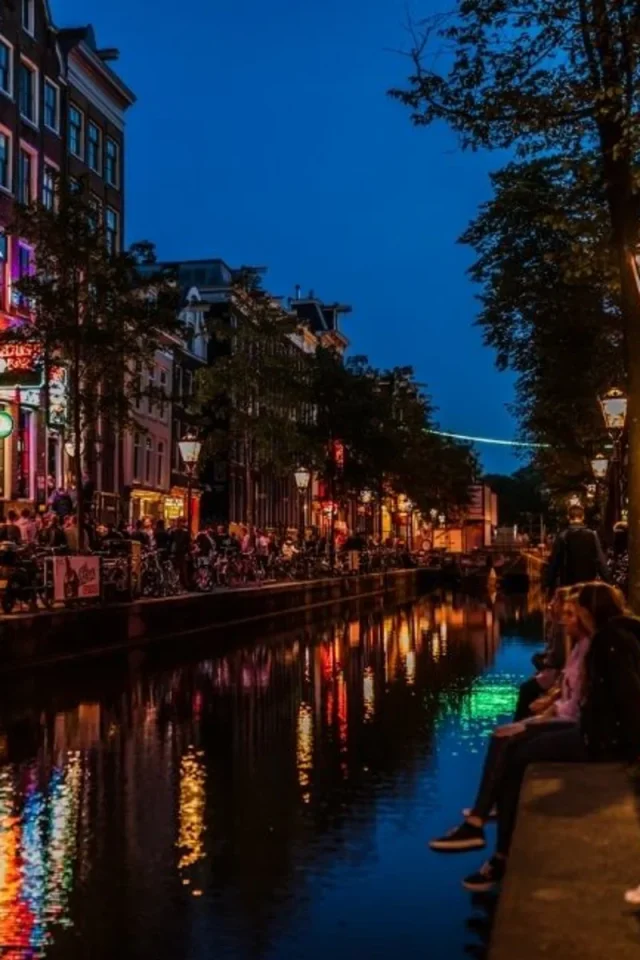Amsterdam, a city renowned for its picturesque canals and historic charm, has long been a magnet for those seeking adventure and excitement. Its vibrant nightlife, once a captivating symphony of lights, music, and laughter, drew visitors from all corners of the globe. However, this nocturnal extravaganza now faces a constellation of challenges that threaten its very essence.
In the heart of the city center, districts like the infamous Red-Light District and bustling Rembrandtplein have become both magnets and battlegrounds. The allure of these areas has led to an overwhelming influx of tourists, like moths to a flame, transforming the cobblestone streets into a chaotic tapestry of clashing desires. The once-harmonious nightlife has given way to overcrowding, noise disturbances, safety concerns, and friction among venues, residents, and governing bodies.
As twilight descends, the cityscape transforms into a cacophonous blend of laughter, music, and revelry. The revelry, however, doesn’t confine itself to the clubs and bars. It spills onto the streets, merging with the quiet desires of the city’s residents. Noise complaints rise like a crescendo, as the serenity of night is shattered by blaring music, raucous shouts, and even the unsightly Specter of public vomiting.
Yet, the discord doesn’t stop at noise alone. Alcohol-fuelled violence casts a dark shadow over the city’s reputation. When the curtains fall on the bars, intoxicated patrons spill into the streets, their revelry turning into brawls. Rembrandtplein, once a stage for creativity and celebration, witnesses over 300 violent incidents annually, painting a grim portrait of Amsterdam’s nightlife.

To compound the challenges, Amsterdam’s nocturnal transit system is a symphony out of tune. Public transportation comes to a halt early in the night, leaving revellers with little choice but to rely on rideshares, taxis, or private vehicles. The streets become congested, and the city’s resources strained.
As the hands of the clock edge toward midnight, the options for a proper sit-down meal dwindle. The lack of amenities catering to nighttime activities leaves a gaping void in the city’s offerings, leaving those hungry for a late-night reprieve with limited choices.
The roots of these challenges run deep, stemming from the very core of Amsterdam’s nightlife infrastructure. The concentration of venues within the city center creates a pressure cooker of issues, as establishments vie for attention in tight spaces. This magnifies problems of overcrowding, noise, and safety. Communication breakdowns between government bodies, businesses, and residents further exacerbate the disharmony, breeding friction instead of cooperation.
Restrictive policies dictating early closing times only intensify the chaos. The abrupt exodus onto the streets ignites disorder, tarnishing the magic of the night. Moreover, the city’s infrastructure, from transit to sustenance, is ill-equipped to support a thriving nocturnal economy, casting shadows over its sustainability.
Nonetheless, Amsterdam refuses to let its nocturnal symphony fall into silence. Recent efforts, starting from May 2023, have brought new hope. The ban on smoking marijuana on Red Light District streets aims to decrease disturbances and foster respect. An advertising campaign targets rowdy “nuisance tourists,” urging more considerate behaviour. Prostitution windows have been reduced, and plans to move some away from the district are underway. Extended club hours during major events disperse crowds, enhancing safety. The introduction of “night hosts” ensures order in nightlife areas. Select venues outside the city center now operate 24/7, reducing pressure on central districts.
Amsterdam cherishes its nightlife as a cultural and economic asset, committed to resolving noise, safety, and overcrowding issues. Collaborating with operators and residents is the key to restoring harmony. Public opinion varies, with some finding regulations too restrictive and others welcoming them as a curb to undesirable behaviour.
The challenges have strained both resident and visitor experiences, eroding the community’s connection with the city’s allure. Reduced quality of life due to noise and safety concerns has strained relationships. Limited operating hours have left nighttime untapped, hindering economic potential. Amsterdam’s reputation as an uncontrolled party hub deters mainstream visitors while pushing some to risky underground parties.
Yet, amid these challenges, hope twinkles like stars in the night sky. Solutions can emerge, harmonizing resident, business, and visitor needs. Amsterdam’s nightlife can transform once again, painting the cobblestone streets with a new, balanced, and vibrant palette. As the city navigates its nocturnal symphony, the challenge lies in composing a melody where everyone can dance to the rhythm of the night.
Author:
Mridula Vishwanathan, Intern
Internship Programme
University Of Dundee
Scotland, UK
Mentor:
Marija Lazarevic, MSc
CEO MariXperience Ltd.
Montenegro

